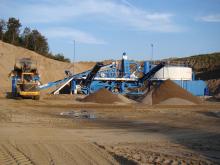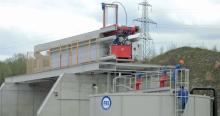
From January 2009 ground water in Europe will be protected by new legislation. ABE takes a look at the new Water Framework Directive and the options for quarry operators
Management of water demand in Europe is an important issue. In the past increased demand has been met by developing new abstraction sources because of the availability and low cost of taking this route. However, with environmental issues coming to the fore, the relationship of water abstraction and availability has become increasingly focused on sustainability.
In Europe the Water Framework Directive (2000/60/EC) set out requirements for management and protection of surface water against water pollution. The legislation does not currently extend below the surface, however that will change in January 2009 with the adoption of a 'daughter directive' aimed at protecting groundwater.
Quarry operators have long worked to reduce the impact on the environment from the discharge of surface water, but under the new guidance the impact on groundwater will also have to be assessed.
Groundwater
The Water Framework Directive (WFD) sets objectives for groundwater quality, including an objective to meet "good chemical status" by 2015; an objective on pollution trends; and an objective to prevent or limit the input of pollutants to groundwater. Clarification of the objectives was left to the daughter directive, which was first proposed by the
Co-decision on the text for the new directive was reached in October 2006 and the directive was adopted on 12 December 2006. Member States have until January 2009 to bring into force laws, regulations and administrative provisions to implement the new directive.
Under the new legislation, quarry operators in Europe will need to not only add procedures to protect both groundwater and surface water around the quarry but also consider how to reduce water consumption for processing applications.
According to Italian firm Fraccaroli & Balzan, innovative solutions for wastewater treatment in quarrying applications are already available. The company has said that it is seeing a growing market, particularly now that environmental legislation is becoming more rigidly enforced. "The technology is well-proven and was developed originally for use in marble quarries but has now been broadened to suit duties in an array of aggregate applications as well," said Fraccaroli & Balzan's Nicola Zago.
These systems are of particular importance in areas where water is in short supply and its use poses an additional operating cost as they allow a significant portion of the water to be re-used, with up to 90% recycling in marble quarrying applications and 80% in aggregates duties.
In applications where environmental legislation or water availability proves tricky (taxes are levied/litre of water used in some countries), Fraccaroli & Balzan said that recycling plants can easily pay for themselves within a year.The environmental implications are enormous too, as these systems tackle problems of wastewater spillages into rivers or lakes, a subject of Groundwater legislation
The path towards groundwater protection in Europe started with the 1980 Groundwater Directive, which required all countries to prevent discharge of hazardous substance and limit others to avoid pollution.
A decade later the Nitrates Directive was adopted and member states then had to apply control measures on the agricultural industry to prevent pollution of drinking water, rivers and lakes. Another part of the new ruling also required groundwater to be kept pesticide free.
Although the legislation set out objectives, little was done to achieve these aims and the rising rate of pollution was not being addressed. The Water Framework Direction adopted in 2000 moved the debate forwards but did not provide a clear way for implementation to become more widespread. The new Groundwater Directive has been designed to address these difficult issues.
The new directives build on the 'prevent and limit' approach of previous legislation buts this adds to a more holistic eco-system based model, which the EU believes gives member states more flexibility.increasing concern in the current market. The Nordic countries as well as Germany, Austria, Switzerland, France and Northern Italy already have strict enforcement of regulations on wastewater from quarrying operations. But these regulations are increasingly coming into play in Spain and Southern Italy already and are likely to be enforced in Eastern European countries too in the near future.
Recycling
The basic concept is similar for all the units. Wastewater enters the plant and is agitated so that chemicals can be added. The heavy particles then sink to the bottom and the clean water can be drawn off from the top.
"To dimension the plant, we ask the customer how many thousand litres of water they use. For every cubic metre of aggregate produced, they need 1.5-2m3 of water. The target of the plant is to have clean water and a reduced volume of mud. We also sample the water and test it to find the percentage of mud. We always go to the customer and test because we must certify the method is correct for the application," explained Zago.
The largest plant built so far was for a customer in Switzerland and is able to handle 14,000litres of water/min, while a 10,000litre/min plant has been built for a customer in Germany. However, a throughput of 2,000-5,000litres/min is the most common size range for a dewatering plant.
The filter presses are made to Fraccaroli & Balzan's own specifications and can be tailored to meet the particular needs of each dewatering application according to the firm. The presses are PLC controlled with sensors that detect when the water stops dropping out of the material under pressure and then open so as to let the cakes fall out.
Once the water has been squeezed out of the mud, the waste material is left to dry and this neutral product can be used for backfilling purposes or as sub-base for road construction.
The biggest press Fraccaroli & Balzan has made so far featured 80 plates measuring 1.5 x 1.5m and this was able to fit onto a 13.6m maximum truck length, although the company said it is able to build units featuring up to 100 plates (such a unit would require special transport requirements though). Key features of the filter presses developed by Fraccaroli & Balzan for the quarrying cycle include an innovative integral automatic plate washing system and the use of textiles specially selected for the application.
According to Zago, use of filter presses to recycle process water in quarries can not only reduce the operational costs at the site, but also significantly lower the environmental risks associated with groundwater and surface water pollution








